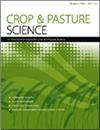硅对热胁迫菠菜生物量产量和生理生化特性的改善
IF 1.9
4区 农林科学
Q2 AGRICULTURE, MULTIDISCIPLINARY
引用次数: 2
摘要
抽象的上下文。硅增强了植物对生物和非生物胁迫的防御作用。菠菜(Spinacia oleracea L.)是一种营养丰富的叶菜,是一种耐寒但热敏的作物。目标和方法。外源施用Si(0、2、4和6 mmol L−1以K2SiO3的形式)缓解菠菜热应激的能力。Desi Palak接受了调查。驯化期结束后,分别在有热胁迫和无热胁迫条件下生长15 d,再进行硅处理25 d。播种后65 d对植株生长和生理进行评价。关键的结果。热胁迫显著抑制了菠菜叶片的生长、水分状态和光合作用、可溶性糖和蛋白质含量以及渗透物状态,但增加了电解质泄漏、抗氧化酶活性和脯氨酸含量。硅通过改善水分状态、光合色素、可溶性蛋白和必需矿物质以及减少质膜损伤来缓解热应激。渗透物的积累抵消了热造成的渗透压力。结论。硅通过改善水分状态和光合速率,积累脯氨酸以外的渗透保护剂,在缓解热应激效应方面起着至关重要的作用。的影响。外源施硅是提高菠菜植株耐热性的有效策略,对菠菜在高温下的生长和产量有显著影响。本文章由计算机程序翻译,如有差异,请以英文原文为准。
Silicon-mediated improvement of biomass yield and physio-biochemical attributes in heat-stressed spinach (Spinacia oleracea)
Abstract Context. Defensive action of plants against biotic and abiotic stresses has been augmented by silicon (Si). Spinach (Spinacia oleracea L.) is a nutritious leafy vegetable that is a cold-tolerant but heat-sensitive crop. Aims and methods. The ability of exogenous application of Si (0, 2, 4 and 6 mmol L−1 in the form of K2SiO3) to alleviate heat stress in spinach cv. Desi Palak was investigated. After an acclimatisation period, plants were grown with or without heat stress for 15 days, followed by Si treatment for 25 days. Plant growth and physiology were assessed at 65 days after sowing. Key results. Heat stress significantly inhibited plant growth, water status and photosynthesis, soluble sugar and protein contents, and osmolyte status in spinach leaves, but increased electrolyte leakage, activities of antioxidant enzymes, and proline content. Application of Si alleviated heat stress by enhancing water status, photosynthetic pigments, soluble proteins and essential minerals, and by reducing damage of the plasma membrane. The accumulation of osmolytes counterbalance the osmotic stress imposed by heat. Conclusions. Silicon plays a vital role in alleviating effects of heat stress by improving water status and photosynthetic rate, and accruing osmoprotectants other than proline. Implications. Exogenous application of Si is an efficient strategy to boost tolerance of spinach plants to heat stress, having significant impact on growth and productivity of spinach at higher temperatures.
求助全文
通过发布文献求助,成功后即可免费获取论文全文。
去求助
来源期刊

Crop & Pasture Science
AGRICULTURE, MULTIDISCIPLINARY-
CiteScore
4.20
自引率
15.80%
发文量
111
审稿时长
3 months
期刊介绍:
Crop and Pasture Science (formerly known as Australian Journal of Agricultural Research) is an international journal publishing outcomes of strategic research in crop and pasture sciences and the sustainability of farming systems. The primary focus is broad-scale cereals, grain legumes, oilseeds and pastures. Articles are encouraged that advance understanding in plant-based agricultural systems through the use of well-defined and original aims designed to test a hypothesis, innovative and rigorous experimental design, and strong interpretation. The journal embraces experimental approaches from molecular level to whole systems, and the research must present novel findings and progress the science of agriculture.
Crop and Pasture Science is read by agricultural scientists and plant biologists, industry, administrators, policy-makers, and others with an interest in the challenges and opportunities facing world agricultural production.
Crop and Pasture Science is published with the endorsement of the Commonwealth Scientific and Industrial Research Organisation (CSIRO) and the Australian Academy of Science.
 求助内容:
求助内容: 应助结果提醒方式:
应助结果提醒方式:


